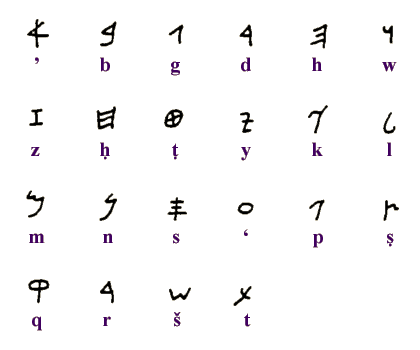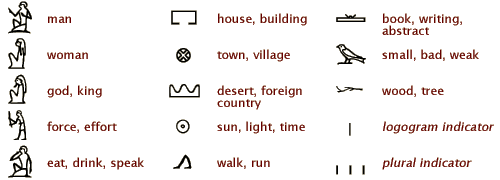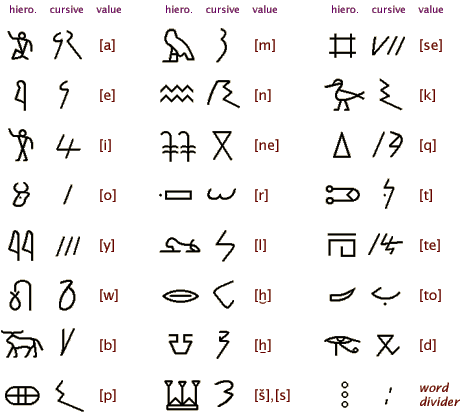|
Historical Alphabets
|
||
|
ARAMAIC |
||
|
|
||
|
CYPROTIC |
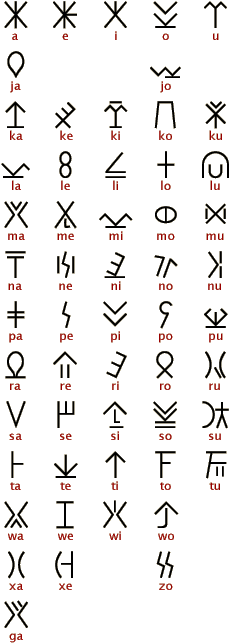 |
|
|
EGYPTIAN
HIEROGLYPHS How It Works The Egyptian writing system is complex but relatively straightforward. The inventory of signs is divided into three major categories, namely (1) logograms, signs that write out morphemes; (2) phonograms, signs that represent one or more sounds); and (3) determinatives, signs that denote neither morpheme nor sound but help with the meaning of a group of signs that precede them. The following are the uniconsonantals: |
||
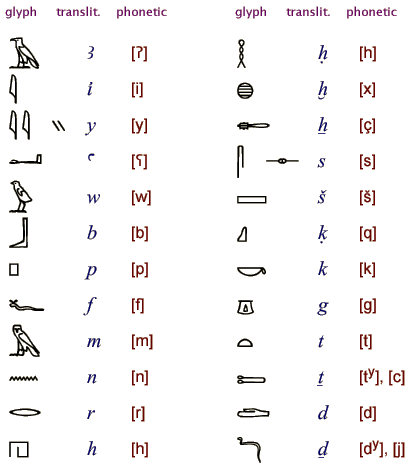 |
||
|
And a few biconsonantals and triconsonantals: |
||
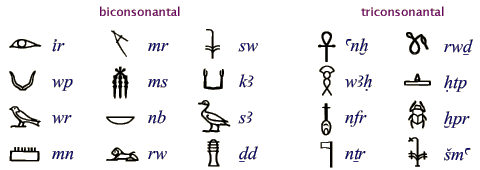 |
||
| And a few nonphonetical ones: | ||
|
|
||
|
EGYPTIAN
MEROITIC There are two major scriptal traditions, the hieroglyphic and the cursive. The hieroglyphic signs were written in columns from top to bottom, and appear all most exclusively on monuments. The cursive style flows usually in horizontal lines from right to left. For both cases signs read in the direction which the figures face (ie if the sign that looks like a bull faces right, then you start from the right and goes left). A glance at the phonetic values of the signs indicates some strange mixture of alphabetic and syllabic signs. In reality this system was really a minimalistic syllabary much like Old Persian. The signs that appear to stand for consonantal sounds are really combinations of that consonant plus the vowel 'a'. However, these same signs changes to be purely consonantal if followed by vowels 'i', 'e', or 'o'. Furthermore, the glyph for 'a' was used only in the beginning of words (where a syllabic 'a' might occur). In addition, to represent a simple consonant sound unattached by any vowel, the symbol for for 'e' was written after the consonantal sign to indicate the lack of the default vowel 'a' following the consonant. |
||
|
|
||
|
Before Rome became the dominant state of the Italic Peninsula and imposed its culture and language on the non-Roman Italic population, there were a bewildering number of ethnic and linguistic groups that thrived in the Peninsula. One of these groups is the Oscans, who occupied the southern part of the Peninsula that were not settled by Greeks. The Oscan speakers adopted the Etruscan alphabet to write their language. This event probably occurred around the 7th century BCE but the first evidence of the Oscan alphabet did not appear until the 5th century BCE in the form of inscriptions on coins. Because the Oscan language is Indo-European, its phonology is different from that of Etruscan. As a result, many letters not used in Etruscan but inherited from Greek were revived to denote Oscan sounds such as [b], [g], and [d]. Sometimes the u letter is used to denote the [o] sound (which did not exist in Etruscan and therefore there was no letter for it). Also, two new letters were invented during the 4th century BCE, namely í and ú, for the long vowels of [i:] and [u:]. The total tally of letters in the Oscan alphabet is therefore 21.
|
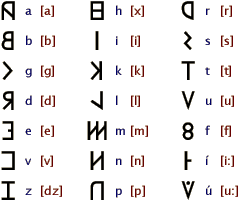 |
|
|
The Phoenician script is an important "trunk" in the alphabet tree, in that many modern scripts can be traced through it. Arabic, Hebrew, Latin, and Greek scripts are all descended from Phoenician. Phoenician is a direct descendent of the Proto-Sinatic script. Like Proto-Sinaitic, Phoenician is a "consonantal alphabet", also known as "abjad", and only contains letters representing consonants. Vowels are generally omitted in this phase of the writing system. The major change between Proto-Sinaitic and Phoenician is graphical. The Phoenician letter shapes grew to be more abstract and linear, in comparison to the more "pictographic" shape of Proto-Sinaitic signs. |
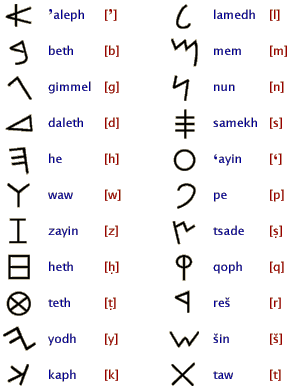 |
|
|
Around the time of the first great Persian Empire of the Achaemenids around 500 BCE, Persian was written in a cuneiform syllabary. It was not a direct descendent of Sumerian and Akkadian systems, because even though Old Persian is cuneiform, its signs did not correspond to earlier signs. Old Persian only kept the cuneiform appearance of its character simply out of tradition, and the actual shape of the signs were completely original. The following is the Old Persian syllabary. Notice that this is a very skeletal syllabary, in that sounds like pu is written with the signs pa and u. In fact, consonants are written with the signs of the form C-a, where C is consonant that we want to represent. This is the Old Persian syllabary: |
||
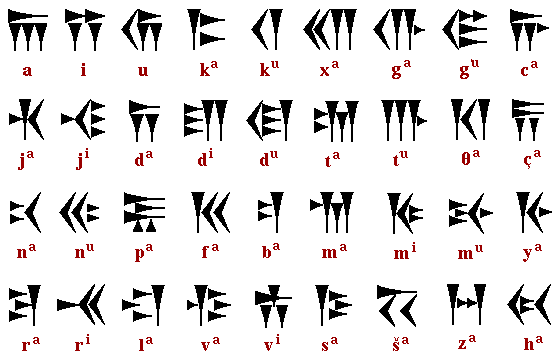 |
||
| These are the logograms used in Old Persian: | ||
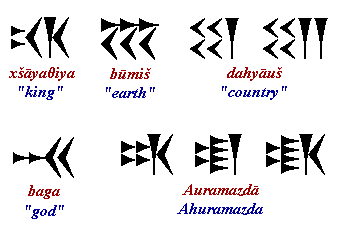 |
||
| And these are numbers in Old Persian: | ||
 |
||
|
UGARITIC
CUNEIFORM This writing system was employed in the city of Ugarit, located in western Syria from around 1300 BCE. It later was supplanted by the West Semitic, Proto-Canaanite-descended scripts. |
||
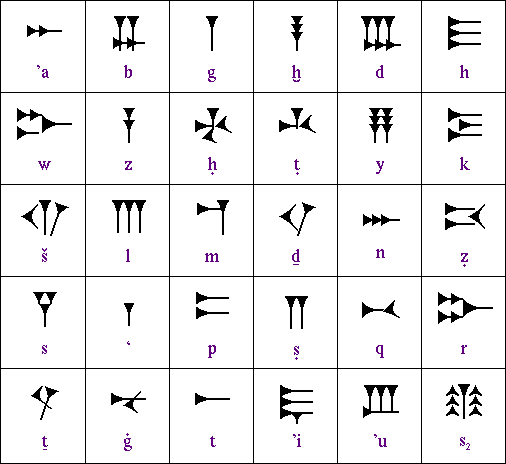 |
||
| IBERIAN
SCRIPTS As its name implies, the Iberian scripts were found mainly in Spain and Portugal, although some are found in southern France as well. The Iberian family of scripts is consisted of two "styles", called Northeast and South. Structurally they are more or less the same, and the major difference between them is (a) geographical location, and (b) shape of the characters. Both Iberian scripts contain monophonemic (that is, only one sound, sort of like alphabetic) signs as well as syllabic ones. |
||
 |
||
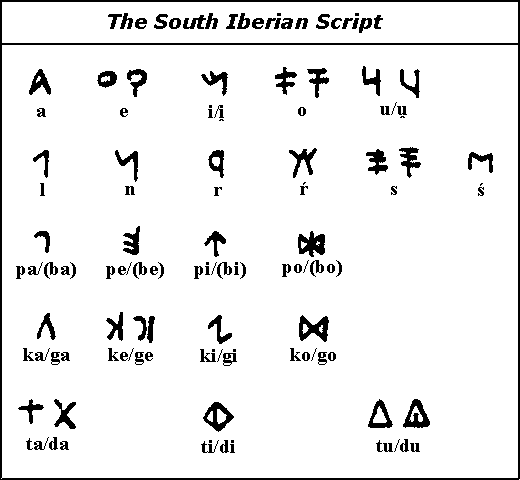 |
||
| VENETIC
RUNIC The Venetics were a people that inhabited the northern coast of the Adriatic Sea during the Iron Age, roughly from 1000 BCE until domination by the Roman Empire. Known as Veneti to the Romans and Enetoi to the Greeks, they gave their name to the region of Veneto and also to the city of Venice (even though at this time Venice was still a swampy lagoon). They left over two hundred inscriptions in their distinctive script, which is very obviously related to the Etruscan script and ultimately derived from the Greek model. The Venetic script might even be the source of the Futhark Runic Script. The following is the Venetic alphabet. Some of the letters have multiple forms that correspond to regional differences. Also, note that the sound [f] is represented by a combination two letters, either hv, or vh, which is a trait found also in Etruscan and early Latin. |
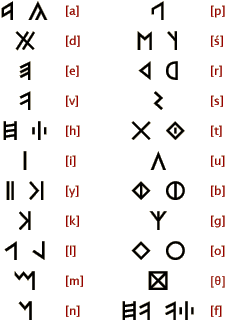 |
|
| FUTHARK
RUNIC STYLES In popular culture, Runes have always been seen as possessing of mystical properties. Once in a while a fantasy computer game comes by with puzzles written in runes, and many modern Wiccan sects use Runes ceremonially and ritualistically. As runes dated from before the time Northern Europe became Christianized, it became associated with the "pagan" or non-Christian past, and hence a mystique is cast upon it. Even the supposed etymology of the word rune, the German word raunen which means "to whisper", helped in adding a secretive bend to Runes. The Runic alphabet is also known as Futhark, a name composed from the first six letters of the alphabet, namely f, u, th, a, r, and k. In this way, "Futhark" is analogous to the word "alphabet", which is from alpha and beta, the first two letters of the Greek alphabet. And why were the letters ordered in such a way. Nobody knows the answer, but it might been some form of mneumonic function that was not preserved. The first Runic inscriptions that have survived to the modern day dated from around 200 CE. The alphabet consists of 24 letters, 18 consonants and 6 vowels, as illustrated in the following chart: |
||
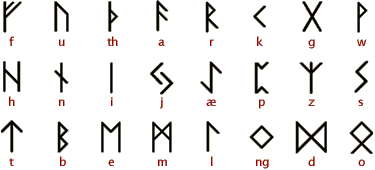 |
||
| The Futhark of 24 letters is called "Elder Futhark", and was used mostly before the 9th century CE. In England, the Anglo-Saxons brought Futhark from continental Europe in the 5th century CE and modified it into the 33-letter "Futhorc" to accommodate sound changes that were occurring in Old English, the language spoken by the Anglo-Saxons. Even the name "Futhorc" is evidence to a phonological change where the long /a/ vowel in Old English evolved into a later /o/ vowel. The new letters compensated for sound changes in Old English. For example, the Elder Futhark letter k became the Futhorc letter c, which was pronounced as /k/ before mid and back vowels (/a/, /o/, /u/) and as /c/ before front vowels (/e/ and /i/), so a new Futhorc letter, k, was created to always represent the sound /k/ regardless of the following vowel. Similarly, the Elder Futhark letter g came to represent /g/, /y/, and /gh/, so a second g letter was invented to consistently represent the /g/ sound. And finally, many new vowels arose in Old English, so a lot of new vowel letters were created. | ||
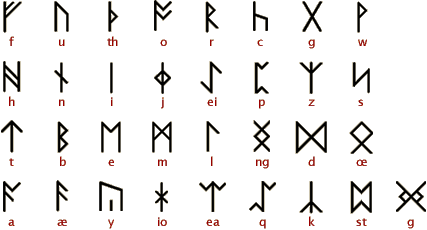 |
||
| In Scandinavia, Futhark also evolved around the 9th century CE. Instead of 24 letters, the Scandinavian "Younger" Futhark had 16 letters. Nine of the original Elder Futhark letters were dropped (g, w, æ, p, z, e, ng, d, and o), and a new one was created (R). There were two major varieties of Younger Futhark, namely Danish and Swedish-Norwegian, as illustrated in the following chart: | ||
 |
||
| The cause of this reduction of letters in Younger Futhark is tied to very complex phonological changes that occurred in the Old Nordic language. As many old letters were removed from the alphabet, several of the remaining letters were overloaded to represent multiple sounds: th was used for /þ/ and /ð/; u for /u/ and /o/; k for /k/, /g/, and /ng/; i for /i/ and /e/; t for /t/ and /d/; and b for /b/ and /p/. The new letter, R, was originally used for a /er/-like sound in Old Nordic but became /y/ in later Scandinavian languages. Other derivatives of Futhark are the Manx Script (Denmark 900 AD), the Halsinge Script (Norway 900AD), and the Gullskoen Dotted Script (Scandanavia (900AD-1000AD). | ||
 |
||
| EPI-OLMEC
MESOAMERICAN One of the most amazing thing about Mesoamerican archaeology is that new discovery and theories are constantly appearing. Among one of the most important was the discovery of an inscribed slab found under the waters of the Acula River near the village of La Mojarra in 1986 in the Mexican state of Veracruz. Dubbed Stela 1 of La Mojarra, this monument was inscribed with 465 glyphs arranged in 21 columns, and the image of a ruler. The writing on it is nothing like any other writing system in Mesoamerica, such as Maya, Zapotec, Mixtec, or Aztec, although like the Maya it also used the Long Count. All phonograms in the Epi-Olmec script represent syllables. So we call the set of phonograms the syllabary: |
||
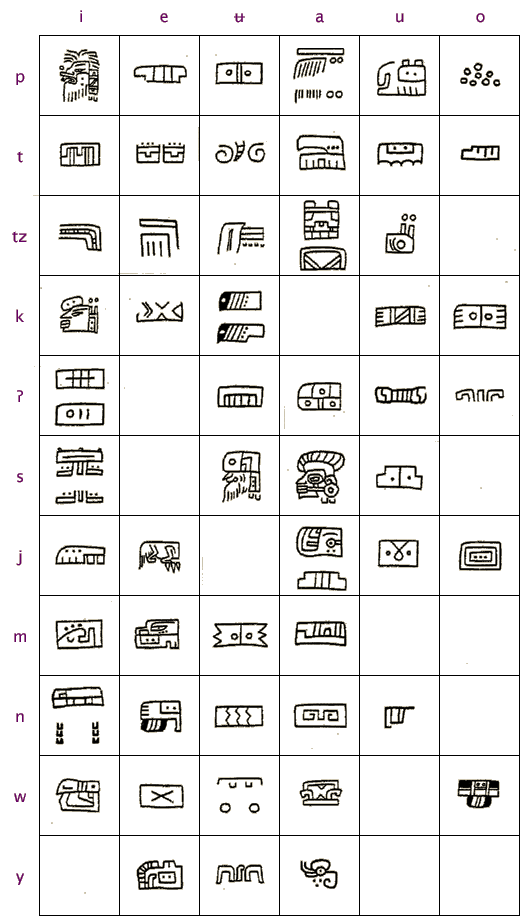 |
||
| OGHAM
SCRIPT Oghams were used to write very old Irish, from 3rd to 6th century of our era. Ogham inscriptions are found exclusively in Ireland, Scotland, and Wales. Mostly they are horribly boring inscriptions in the form of "X son of Y" on corners of large stone slabs. Various opinions exist onto what is the exact origin of ogham. Some claim that it stems from a cryptic way of writing runes, some others say that it is inspired from the Roman alphabet, and yet others hold that it is independently invented. This is the vertical way of writing Ogham. |
||
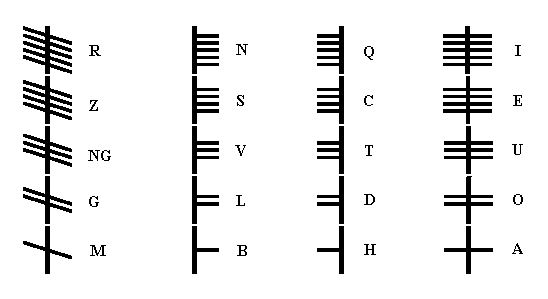 |
||
| Sometimes the vowels use dots rather than lines intersecting the vertical axis. | 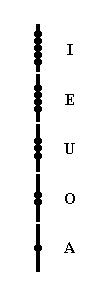 |
|
| And sometimes Oghams lie on the side. This usually occurs in manuscripts. | ||
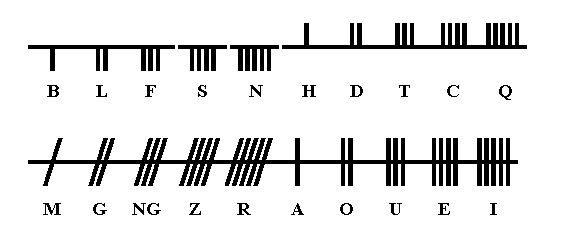 |
||
| THE
SZEKLY RUNIC (Ancient Turkish) The oldest alphabet of the Székely runic writing, the alphabet of Nikolsburg. Kiszely |
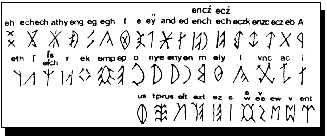 |
|
 |
||
